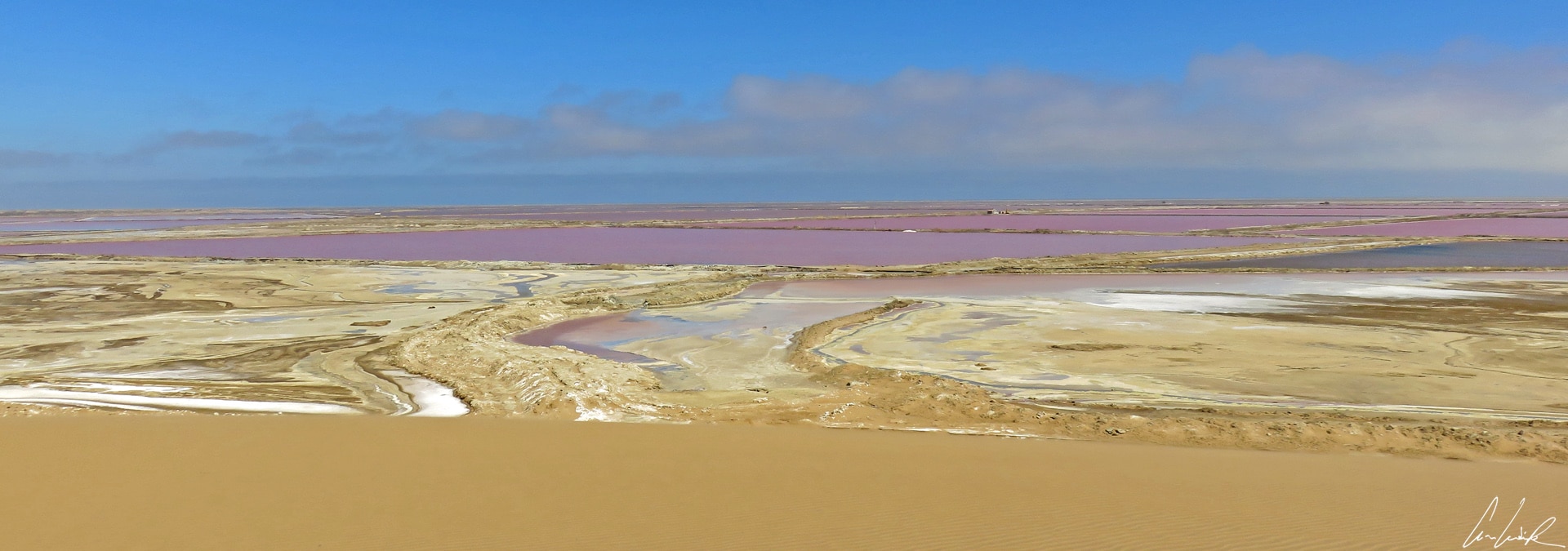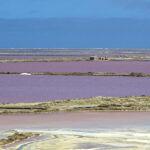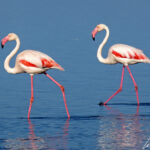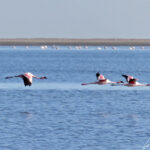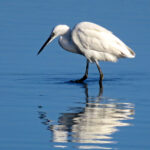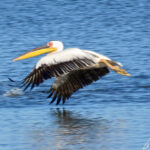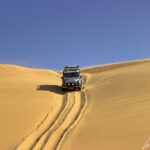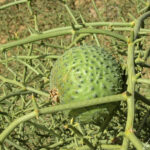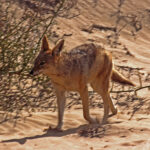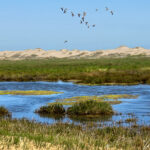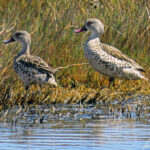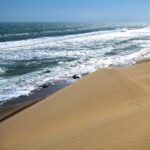Located 22 miles from Swakopmund, the city of Walvis Bay (pronounced « vahl-fis bay ») is a rather unusual place. Travelers often hesitate to visit this small industrial port town, which is often covered by fog. However, it is an essential break in the journey along the long road to Sesriem. This corner of Namibia, trapped between the desert and ocean has much to offer… First of all, the Walvis Bay lagoon is considered the most important swamp in southern Africa and home to abundant birdlife, including white pelicans and Lesser and Pink flamingos. In addition to the ornithological attractions, the Walvis Bay salt fields offer a colorful and varied landscape. Heaven for globetrotting photographers and bird enthusiasts !
A little bit of history of Walvis Bay
Walvis Bay, in German Walfischbucht, and in Afrikaans Walvisbaai, means « bay of whales ». This bay was discovered by the Portuguese navigator Bartoloméu Diaz in 1487, and named « O Golfo de Santa Maria da Conceição (Gulf of Sainte Marie de la Conception) ». It was a safe haven for ships offering a privileged location sheltered from the sea. The site attracted a large number of whalers, and gradually a town of the same name was born in the hollow of the bay. In 1878, Walvis Bay passed to the English crown. The port was strategically located for the export of minerals and in 1920 South Africa was awarded administrative control over South West Africa by the League of Nations. South Africa allowed Walvis Bay to become an international trading port. Ships from all over the world docked in the country’s largest deep-water harbor. In 1990, Namibia gained independence from South Africa, but Walvis Bay remained under South African sovereignty. It was only in 1994 after tough negotiations that South Africa transferred sovereignty over Walvis Bay and the Penguin Islands to the Namibian nation. A visit to the museums and religious buildings of the town helps the traveler understand the history of the region better.
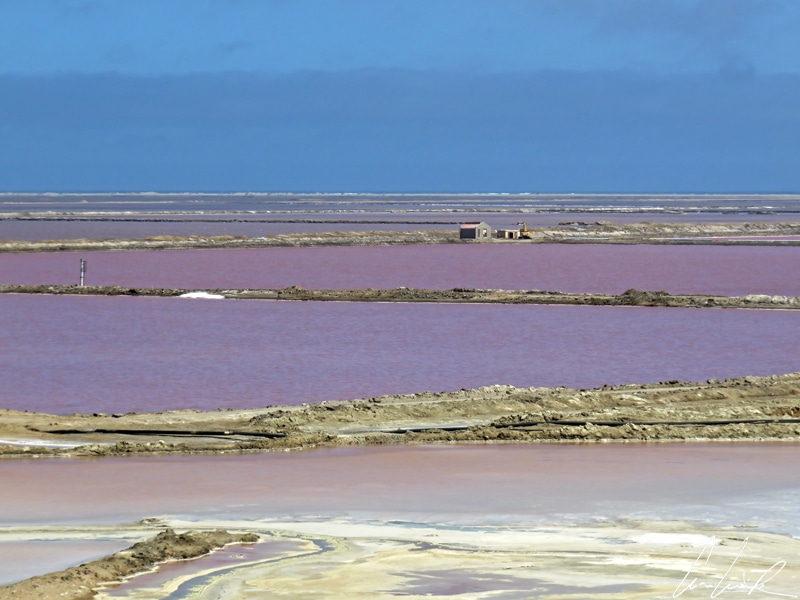
The Walvis Bay Salt Flats: a mosaic of colors in diverse shades of pink
A collection of colors from a palette of shades of pink, the Walvis Bay salt fields offer a unique and enchanting landscape among the dunes. From light pink to fuchsia pink, the contrasts are striking. It is a colorful site dedicated to the white gold that is salt for since 1964 the now man-made landscape has been devoted to the production of salt. The colors come from microscopic microorganisms in the water called « Dunaliella salina » that release beta-carotene, a reddish-pink substance, as part of their photosynthesis process. But by the way, does a salt deposit mean anything to you ? No ? So it’s time to put my grain of salt in this article… Grain of salt, grain of sand or grain of madness, everyone has one, right ?
« Grain: To have one. It doesn’t matter. We’ll deal with it. We speak of it with an air of understanding, a slight movement with the index finger to the head, not without sympathy. Deep down, we each have our own. And it is not forbidden to add a little salt »
(Franck Castagné – Pièces détachées – revue Voix d’encre n° 34)
The salt-producing area covers about 5000 hectares Salt production results from the solar evaporation of seawater and produces 99.4% pure sodium chloride (NaCl) on a dry mass basis. Seawater, which is the only raw material in Walvis Bay, contains a 3.5% concentration of salts with 2.9% sodium chloride. It is pumped from a natural lagoon into a series of pre-evaporation basins at a rate of 240 m3 per minute and then through a series of concentration basins. Stimulated by sea breeze and sun, the salinity of the brine (concentrated salt water) gradually increases to 25%. At this point, it is pumped into crystallization basins, each covering about 50 acres. The minerals become concentrated, and the salt then crystallizes to form a layer of crystals. Thanks to the varieties of algae present in the mineral mixture created at the different stages of desalination, each salt basin sparkles with a stunning shade of violet, red, orange, yellow, and even green.
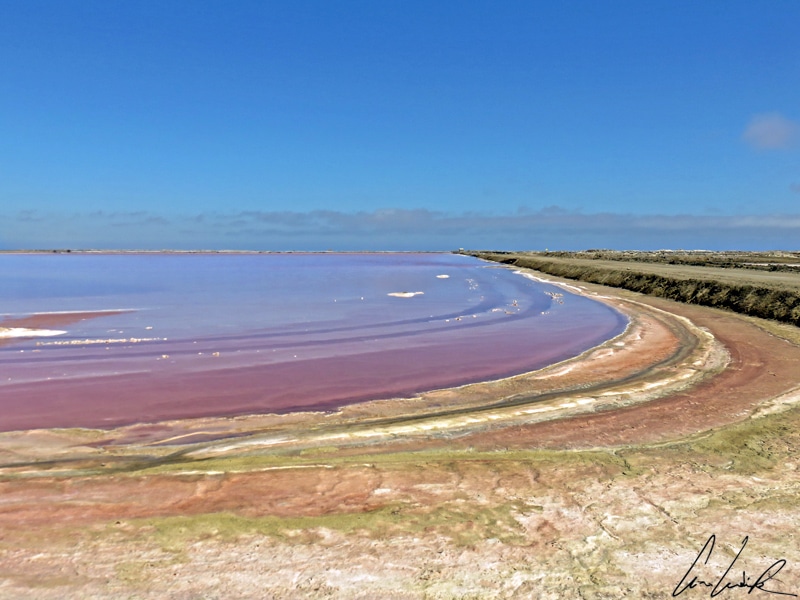
The Walvis Bay Salt Operation is one of the most extensive evaporation facilities in Africa, annually processing 24 million tons of seawater to produce 700,000 tons of high-quality salt annually. When Walvis Bay Holdings Ltd started in 1964, it produced 50,000 tons of salt per year. Most of the salt extracted from Walvis Bay is exported to the southern and western African markets where the chemical industry uses it to make chlorine and caustic soda. The agricultural sector also uses it as a food supplement. Walvis Bay Salt Refiners recently invested in the expansion of its production capacity, the company’s most significant investment in its 54-year history. The new plant now has a washed salt production capacity of 1.1 million tons per year. As a result, salt exports are turning more to an international market. The first shipment of about 50,000 tons went to the East Coast of the United States where the salt is used in various applications such as water treatment and chemical plants.
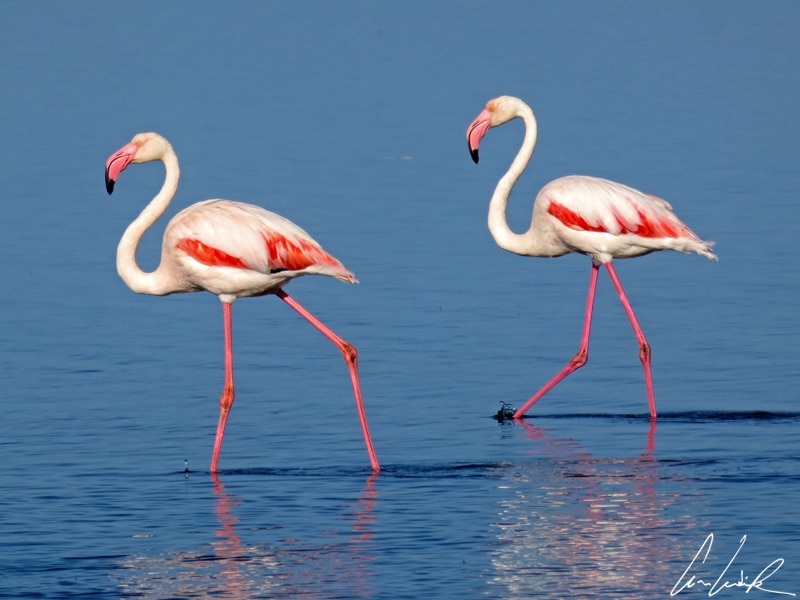
An ornithological journey to Walvis Bay
Walvis Bay is home to the largest colony of Pink flamingos in all Southern Africa. Lesser and pink flamingos gather in large numbers in the plankton-rich lagoon, a bird watcher’s paradise. The flamingo’s long bill is specialized to filter microscopic food, algae and diatoms, from water that is highly alkaline and contains toxic elements. The flamingo supplements its diet of algae with small mollusks, crustaceans and other organic particles living in the mud. To feed itself, it turns in a circle and stomps (the flamingo’s dance) on the ground to flush out a potential meal.
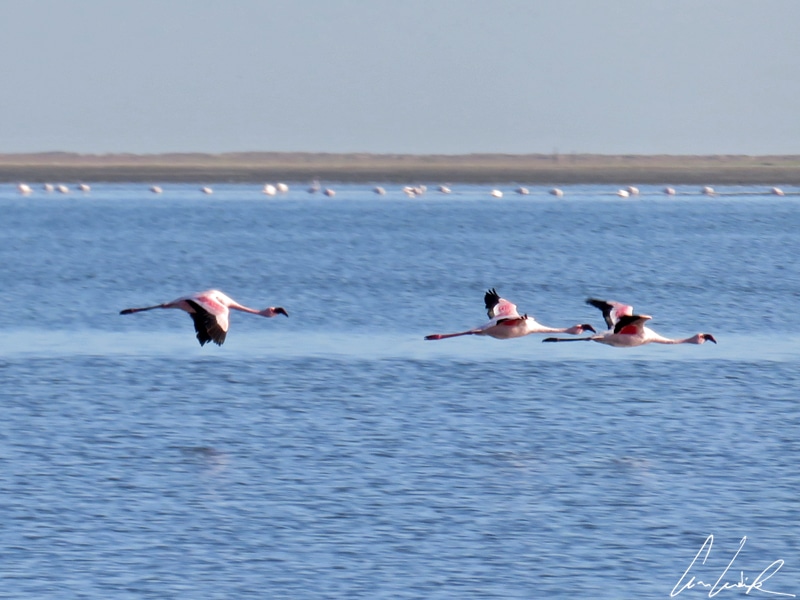
Their color distinguishes Lesser flamingos (Phoenicoparrus minor) from Pink flamingos (Phoenicopterus roseus). Pink flamingos have plumage ranging from white to pale pink and a bill with a black tip. Lesser flamingos display feathers of a more intense pink to reddish hue and have a more intensive black on the bill. The Lesser Flamingo flies in groups, and with their legs extended and can reach a speed of 60 km/h. The Lesser flamingo is the smallest species of flamingo, even though it is a tall and large bird. The total length of even the smallest flamingo is between 35 to 41 inches and its height between 31 and 35 inches. The bird weighs between 2.6 to 6 lbs. The Lesser flamingo does not go unnoticed among the thousands of Pink flamingos with which it mixes. Like all flamingos, the Lesser flamingos lay a single chalky-white egg. The juveniles differ significantly from adults. The juvenile is grey-brown but the newly hatched chick is almost white. What do I see in the distance? A silhouette with immaculate white plumage, but it is not a young flamingo! Sporting a slender and elegant body with a black bill similar to a dagger, it is undoubtedly a Little egret actively seeking its prey in the shallow water, walking quickly in the middle. The Little egret (Egretta garzetta) moves its foot to flush out buried prey which it then captures with its sharp beak… Almost as effective as Arya’s Valyrian steel dagger on the Night King, aka the King of the Night !
« Do you see, Admiral? At dawn, Nigel is already tipsy. We should help the poor man…
Not so fast. Nigel, do you have a frog in your throat? »
(Finding Nemo)
Hello, hello, Admiral ! You are an excellent glider and very graceful. But what are you doing so far from Sydney Bay and with Nigel ? Ah, sorry, but you look a lot like your cousin the Australian pelican. OK, so you are a White pelican (Pelecanus onocrotalus), mea culpa… Yes, yes, I took note of it: almost all-white plumage, except for the black remiges, which are only visible in flight. And also your pale-yellow gular pouch. What, your pouch has a capacity of 3.5 gallons, and you can store up to 9 lbs of fish! Excellent, thank you, Admiral, for all this information from the ocean, and good luck !

Besides these fascinating characteristics recalling the Admiral’s cousin, the pelican also has a very original fishing technique. This seabird is a true believer in collective fishing ! Many pelicans will swim side by side toward the shore, pushing back the fish which they then catch in their gular pouch. Smart, no ?
Sandwich Harbor: when the desert meets the ocean
The significant advantage of Walvis Bay is its proximity to the Namib Desert, which is considered to be the world’s oldest desert. In a few minutes, you reach spectacular dunes on which you can practice your sandboarding skills if you like. These dunes are the tallest in the world, rising in some places more than 1,000 feet above the desert. Although sliding on the sand is undoubtedly a pleasant feeling, we opt instead for an excursion to Sandwich Harbor, a UNESCO World Heritage Site and part of the Namib Naukluft National Park. Namib means « open space » and Namibia « land of open spaces ». The park was established in 1907 by the German colonial administration. The present boundaries were drawn in 1978, and mark an area of 19,216 sq miles. To reach Sandwich Harbor, you have to drive for a while along a beach bordered by the dark green waves of the Atlantic Ocean and to then head for the dunes to reach this unique place where the desert flows into the ocean. Our driver rushes at full speed on these steep slopes: the 4WD goes up and down… thrills guaranteed !

There is life in these dunes ! On sandy slopes, « Acanthosicyos horridus » also known as !Nara (pronounced /[ᵑǃara/), grows in profusion. A species endemic to the Namib Desert, a single shrub of !Nara can form a hummock covering up to 0.38 acre and about 13 feet height. The plant is leafless and consists of thorns and stems forming a dense and intertwined network. This network captures and stabilizes windblown sand, thus helping to form dunes. Its system of thick woody taproots penetrates 165 feet downward into the sand to reach groundwater. The !Nara can survive many years without water. It uses precious water from the morning fog that condenses on its stems.
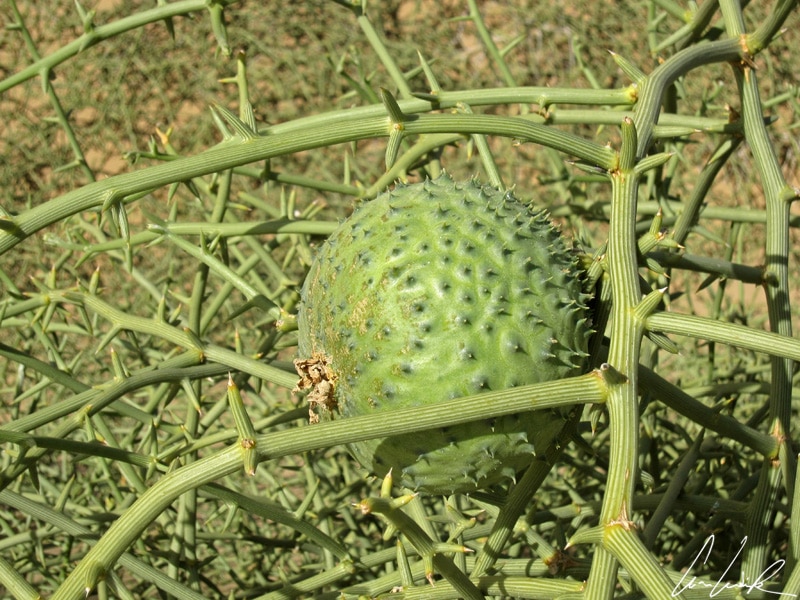
The fruit of this very thorny and always green bush looks like a wild melon. Despite its long thorny stems, it is highly prized by animals seeking a source of water in this hostile environment! Wouldn’t that be a springbok in the middle of this Acanthosicyos horridus ? And near-by a Black-backed jackal cruising around? The fruit of the !Nara serves as an essential food source for the local population, particularly the Topnaars, from February to April and again from August to September. Among the Topnaars, each family owns a number of !Naras, which are considered private property. A family is only allowed to harvest fruit from its own plants. The ripe fruit is sweet and juicy and averages 2.2 lbs. in weight. It is either eaten raw for its high water content or the yellow-orange pulp is dried and made into cakes. The large edible seeds, known as butternuts or butterpips, are rich in protein. They are eaten fresh, roasted as appetizers or ground into flour to be cooked with other dishes. The seed has a pleasant but strange taste, like something between peanut and cocoa….
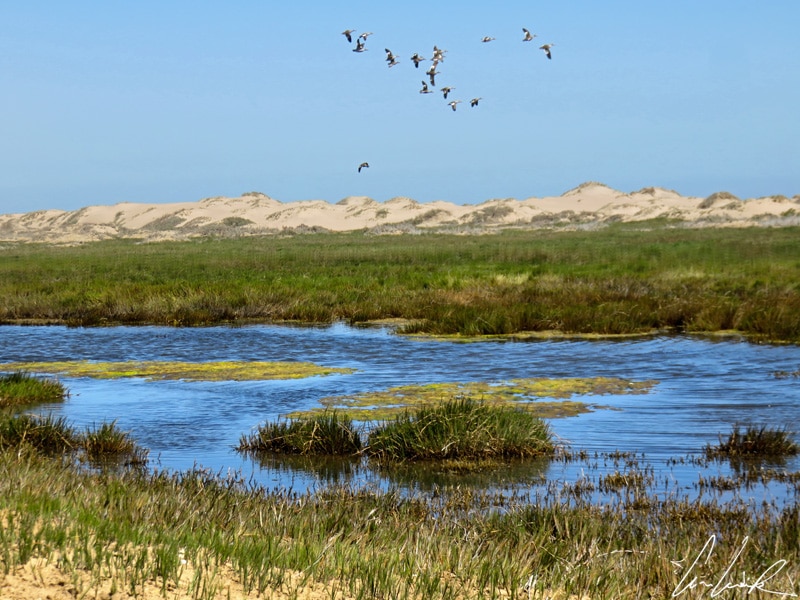
But let’s continue our exploration of the dunes. The wind whips my body and face. The sand flies on the crest of the dunes. It is sublime, but crunches between your teeth! As we progress into the dunes, a small well-hidden lagoon unveils itself in front of us among these millions of grains of sand. Two Piet avocet (Recurvirostra avosetta) with black and white plumage and long upturned bills quickly wander past on elongated and graceful legs, yelling a far-carrying call of « kluit ou klîp ». Their bill is about 3 to 3.5 inches long and their legs between 3 and 4 inches long. Are they warning the Cape Teal (Anas capensis) of our presence? This small stocky duck is also a lagoon dweller. It has pale, mostly grey plumage with a brown back and pink on its bill. We leave this little corner of paradise with regret, but the promised land is not far away… just behind the dune… yes, but behind which one exactly ?
« Let us reward all these travelers !
Something to nicely surprise them
The Promised Land, they really deserve it
They really deserve it
They really deserve it ! »
(La Terre promise – Richard Anthony)

We finally reach the Terre promise ! We climb to the top of a dune to discover an astounding and surrealist landscape painting of gigantic dunes running alongside the ocean as far as the eye can see. A true paradise for any photographer! On both sides, the landscape extends to infinity. And the lower the sun is on the horizon, the more the desert unveils a palette of shimmering colors contrasting with the blue-green of the ocean. Contemplate, take the time to stop to admire the beauty here and now, let the splendor of the landscapes conquer you. A moment of pure happiness !
Find more on Namibia
- Waterberg Plateau Park !
- Lake Otjikoto, a lake that digs its own hole !
- A glimpse of Etosha National Park
- In the heart of the Etosha National Park wildness
- Etosha National Park: A journey to the Animal Kingdom
- Epupa Falls: rendezvous in Himba land
- Encounter with Desert Elephants and Welwitschia Mirabilis
- The Petrified Forest and Rock Carvings of Twyfelfontein
- The Mysterious Skeleton Coast, and Cape Cross’ Fur Seals
